Strategic Management Plan Report: Kellogg's Company Overview
VerifiedAdded on 2023/01/19
|12
|3507
|100
Report
AI Summary
This report presents a strategic management plan for Kellogg's, an American multinational food production company. It begins by defining the business environment and analyzing the macro-environmental factors using PESTEL analysis, considering political, economic, social, technological, environmental, and legal factors within the UK market. The report then delves into the internal micro-environment, utilizing SWOT analysis to assess Kellogg's strengths, weaknesses, opportunities, and threats, followed by a VRIO analysis to evaluate its resources and capabilities. The application of Porter's Five Forces model is discussed to understand the competitive landscape, including threats of new entrants, substitutes, bargaining power of buyers and suppliers. Finally, the report touches upon Porter's generic strategies, providing a comprehensive overview of Kellogg's strategic positioning. The report offers a detailed examination of Kellogg's strategic position and provides insights into its competitive environment.
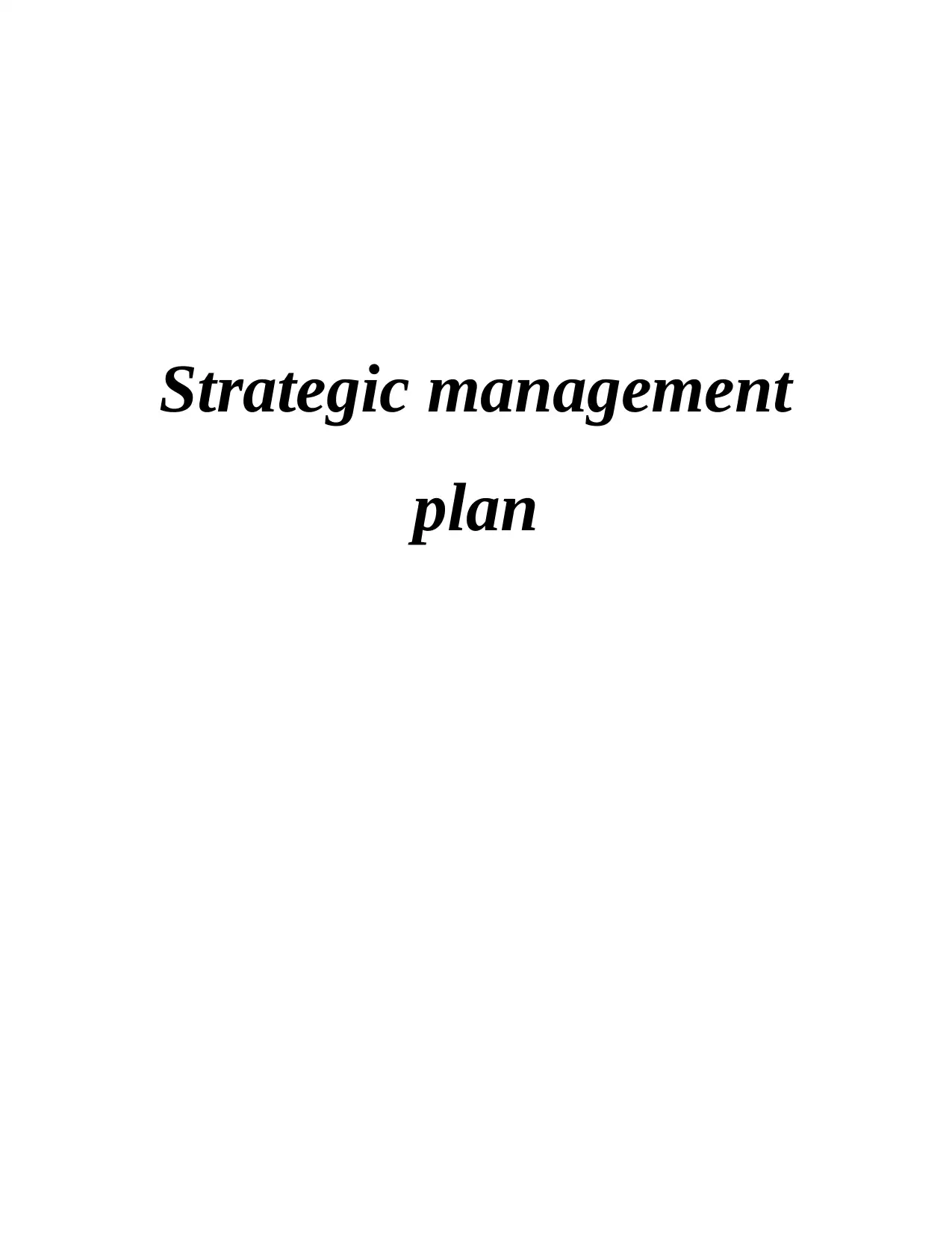
Strategic management
plan
plan
Paraphrase This Document
Need a fresh take? Get an instant paraphrase of this document with our AI Paraphraser
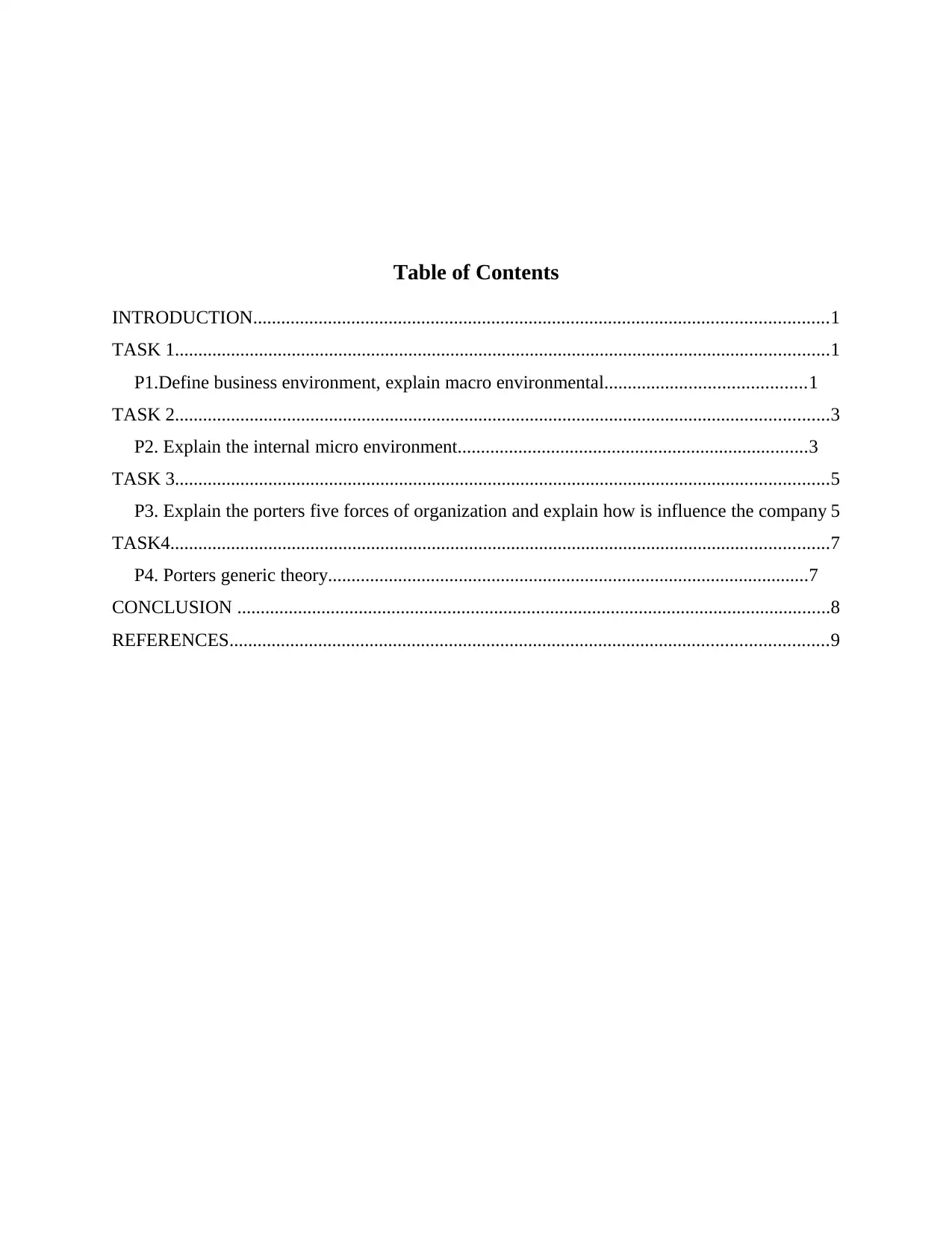
Table of Contents
INTRODUCTION...........................................................................................................................1
TASK 1............................................................................................................................................1
P1.Define business environment, explain macro environmental...........................................1
TASK 2............................................................................................................................................3
P2. Explain the internal micro environment...........................................................................3
TASK 3............................................................................................................................................5
P3. Explain the porters five forces of organization and explain how is influence the company 5
TASK4.............................................................................................................................................7
P4. Porters generic theory.......................................................................................................7
CONCLUSION ...............................................................................................................................8
REFERENCES................................................................................................................................9
INTRODUCTION...........................................................................................................................1
TASK 1............................................................................................................................................1
P1.Define business environment, explain macro environmental...........................................1
TASK 2............................................................................................................................................3
P2. Explain the internal micro environment...........................................................................3
TASK 3............................................................................................................................................5
P3. Explain the porters five forces of organization and explain how is influence the company 5
TASK4.............................................................................................................................................7
P4. Porters generic theory.......................................................................................................7
CONCLUSION ...............................................................................................................................8
REFERENCES................................................................................................................................9
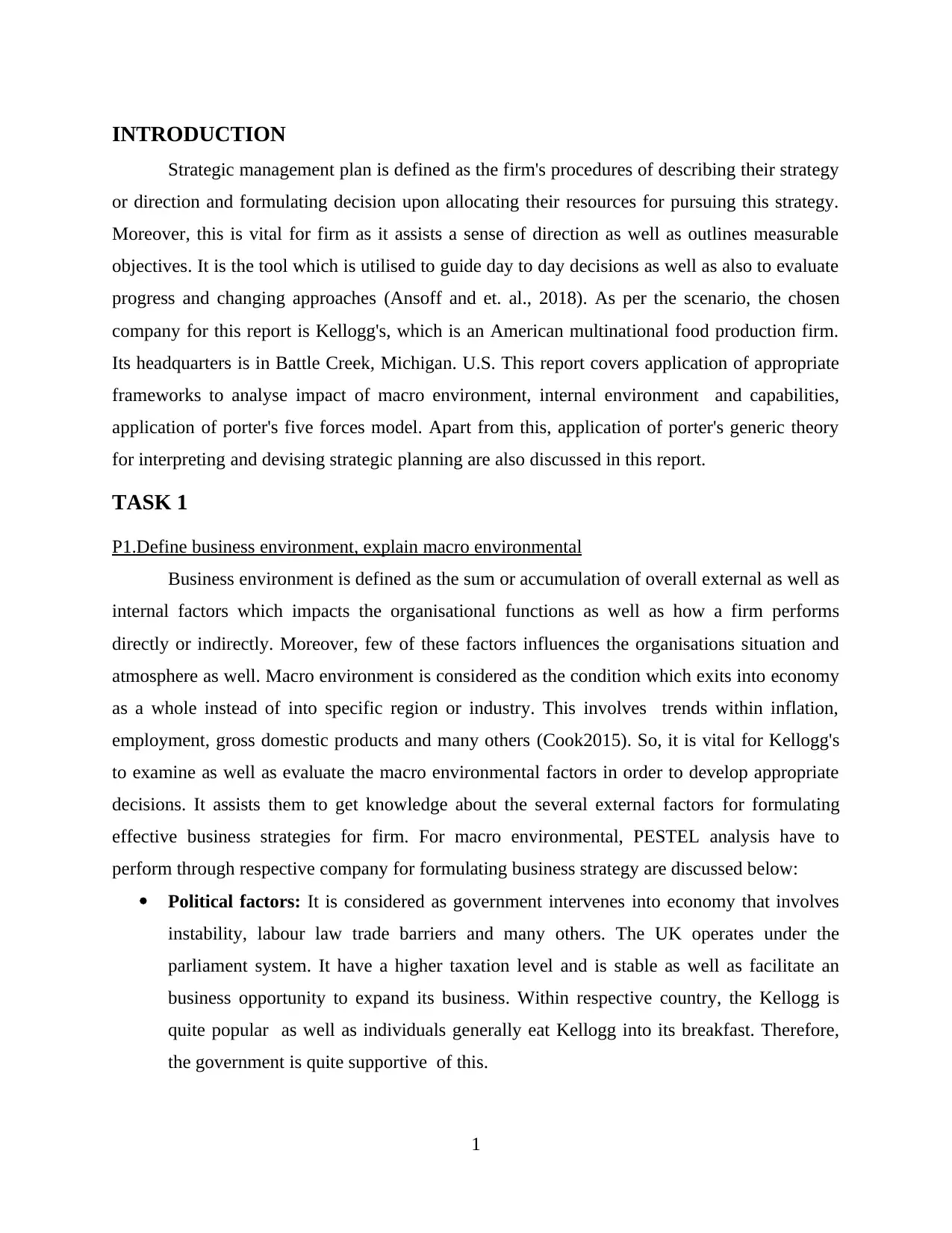
INTRODUCTION
Strategic management plan is defined as the firm's procedures of describing their strategy
or direction and formulating decision upon allocating their resources for pursuing this strategy.
Moreover, this is vital for firm as it assists a sense of direction as well as outlines measurable
objectives. It is the tool which is utilised to guide day to day decisions as well as also to evaluate
progress and changing approaches (Ansoff and et. al., 2018). As per the scenario, the chosen
company for this report is Kellogg's, which is an American multinational food production firm.
Its headquarters is in Battle Creek, Michigan. U.S. This report covers application of appropriate
frameworks to analyse impact of macro environment, internal environment and capabilities,
application of porter's five forces model. Apart from this, application of porter's generic theory
for interpreting and devising strategic planning are also discussed in this report.
TASK 1
P1.Define business environment, explain macro environmental
Business environment is defined as the sum or accumulation of overall external as well as
internal factors which impacts the organisational functions as well as how a firm performs
directly or indirectly. Moreover, few of these factors influences the organisations situation and
atmosphere as well. Macro environment is considered as the condition which exits into economy
as a whole instead of into specific region or industry. This involves trends within inflation,
employment, gross domestic products and many others (Cook2015). So, it is vital for Kellogg's
to examine as well as evaluate the macro environmental factors in order to develop appropriate
decisions. It assists them to get knowledge about the several external factors for formulating
effective business strategies for firm. For macro environmental, PESTEL analysis have to
perform through respective company for formulating business strategy are discussed below:
Political factors: It is considered as government intervenes into economy that involves
instability, labour law trade barriers and many others. The UK operates under the
parliament system. It have a higher taxation level and is stable as well as facilitate an
business opportunity to expand its business. Within respective country, the Kellogg is
quite popular as well as individuals generally eat Kellogg into its breakfast. Therefore,
the government is quite supportive of this.
1
Strategic management plan is defined as the firm's procedures of describing their strategy
or direction and formulating decision upon allocating their resources for pursuing this strategy.
Moreover, this is vital for firm as it assists a sense of direction as well as outlines measurable
objectives. It is the tool which is utilised to guide day to day decisions as well as also to evaluate
progress and changing approaches (Ansoff and et. al., 2018). As per the scenario, the chosen
company for this report is Kellogg's, which is an American multinational food production firm.
Its headquarters is in Battle Creek, Michigan. U.S. This report covers application of appropriate
frameworks to analyse impact of macro environment, internal environment and capabilities,
application of porter's five forces model. Apart from this, application of porter's generic theory
for interpreting and devising strategic planning are also discussed in this report.
TASK 1
P1.Define business environment, explain macro environmental
Business environment is defined as the sum or accumulation of overall external as well as
internal factors which impacts the organisational functions as well as how a firm performs
directly or indirectly. Moreover, few of these factors influences the organisations situation and
atmosphere as well. Macro environment is considered as the condition which exits into economy
as a whole instead of into specific region or industry. This involves trends within inflation,
employment, gross domestic products and many others (Cook2015). So, it is vital for Kellogg's
to examine as well as evaluate the macro environmental factors in order to develop appropriate
decisions. It assists them to get knowledge about the several external factors for formulating
effective business strategies for firm. For macro environmental, PESTEL analysis have to
perform through respective company for formulating business strategy are discussed below:
Political factors: It is considered as government intervenes into economy that involves
instability, labour law trade barriers and many others. The UK operates under the
parliament system. It have a higher taxation level and is stable as well as facilitate an
business opportunity to expand its business. Within respective country, the Kellogg is
quite popular as well as individuals generally eat Kellogg into its breakfast. Therefore,
the government is quite supportive of this.
1
⊘ This is a preview!⊘
Do you want full access?
Subscribe today to unlock all pages.

Trusted by 1+ million students worldwide
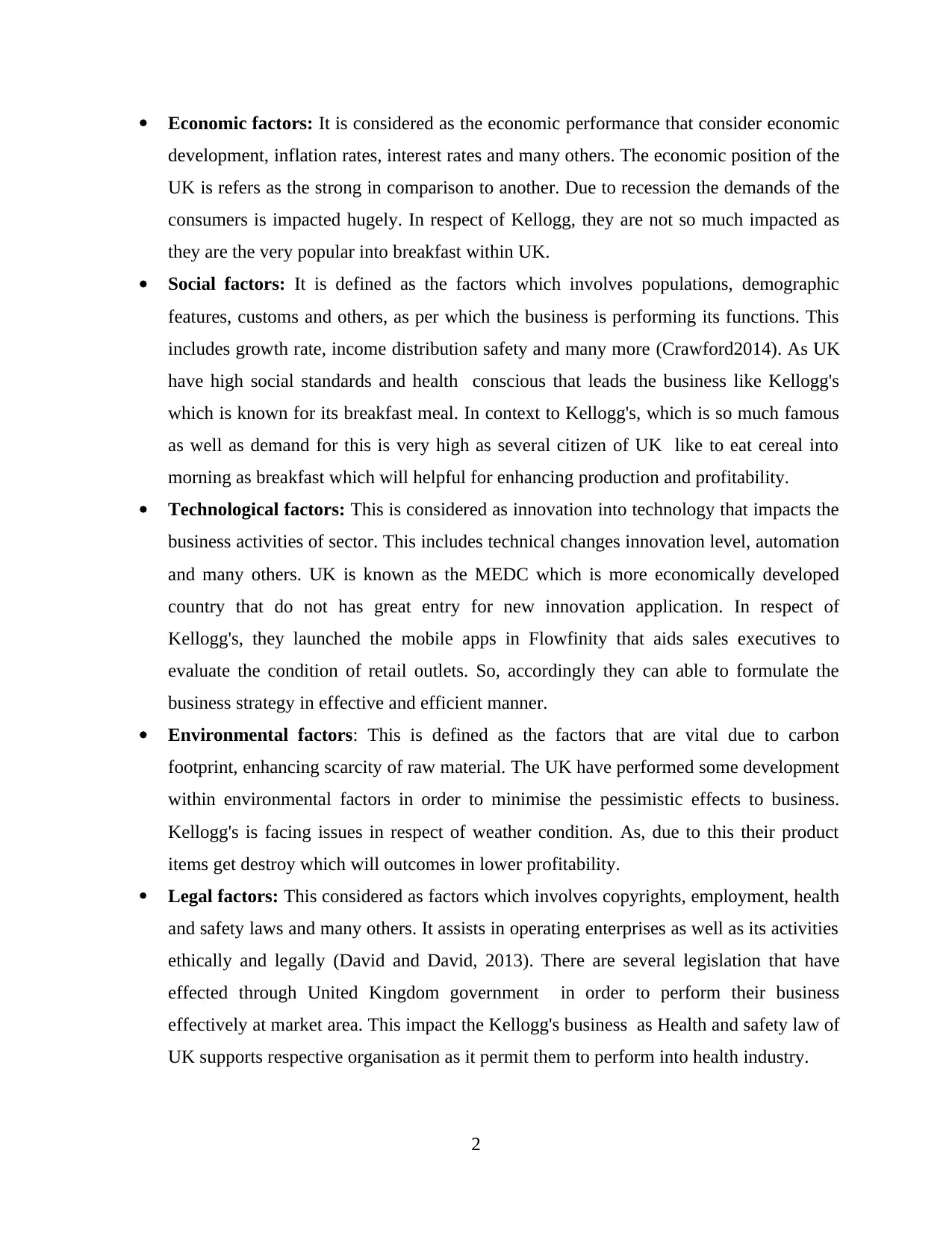
Economic factors: It is considered as the economic performance that consider economic
development, inflation rates, interest rates and many others. The economic position of the
UK is refers as the strong in comparison to another. Due to recession the demands of the
consumers is impacted hugely. In respect of Kellogg, they are not so much impacted as
they are the very popular into breakfast within UK.
Social factors: It is defined as the factors which involves populations, demographic
features, customs and others, as per which the business is performing its functions. This
includes growth rate, income distribution safety and many more (Crawford2014). As UK
have high social standards and health conscious that leads the business like Kellogg's
which is known for its breakfast meal. In context to Kellogg's, which is so much famous
as well as demand for this is very high as several citizen of UK like to eat cereal into
morning as breakfast which will helpful for enhancing production and profitability.
Technological factors: This is considered as innovation into technology that impacts the
business activities of sector. This includes technical changes innovation level, automation
and many others. UK is known as the MEDC which is more economically developed
country that do not has great entry for new innovation application. In respect of
Kellogg's, they launched the mobile apps in Flowfinity that aids sales executives to
evaluate the condition of retail outlets. So, accordingly they can able to formulate the
business strategy in effective and efficient manner.
Environmental factors: This is defined as the factors that are vital due to carbon
footprint, enhancing scarcity of raw material. The UK have performed some development
within environmental factors in order to minimise the pessimistic effects to business.
Kellogg's is facing issues in respect of weather condition. As, due to this their product
items get destroy which will outcomes in lower profitability.
Legal factors: This considered as factors which involves copyrights, employment, health
and safety laws and many others. It assists in operating enterprises as well as its activities
ethically and legally (David and David, 2013). There are several legislation that have
effected through United Kingdom government in order to perform their business
effectively at market area. This impact the Kellogg's business as Health and safety law of
UK supports respective organisation as it permit them to perform into health industry.
2
development, inflation rates, interest rates and many others. The economic position of the
UK is refers as the strong in comparison to another. Due to recession the demands of the
consumers is impacted hugely. In respect of Kellogg, they are not so much impacted as
they are the very popular into breakfast within UK.
Social factors: It is defined as the factors which involves populations, demographic
features, customs and others, as per which the business is performing its functions. This
includes growth rate, income distribution safety and many more (Crawford2014). As UK
have high social standards and health conscious that leads the business like Kellogg's
which is known for its breakfast meal. In context to Kellogg's, which is so much famous
as well as demand for this is very high as several citizen of UK like to eat cereal into
morning as breakfast which will helpful for enhancing production and profitability.
Technological factors: This is considered as innovation into technology that impacts the
business activities of sector. This includes technical changes innovation level, automation
and many others. UK is known as the MEDC which is more economically developed
country that do not has great entry for new innovation application. In respect of
Kellogg's, they launched the mobile apps in Flowfinity that aids sales executives to
evaluate the condition of retail outlets. So, accordingly they can able to formulate the
business strategy in effective and efficient manner.
Environmental factors: This is defined as the factors that are vital due to carbon
footprint, enhancing scarcity of raw material. The UK have performed some development
within environmental factors in order to minimise the pessimistic effects to business.
Kellogg's is facing issues in respect of weather condition. As, due to this their product
items get destroy which will outcomes in lower profitability.
Legal factors: This considered as factors which involves copyrights, employment, health
and safety laws and many others. It assists in operating enterprises as well as its activities
ethically and legally (David and David, 2013). There are several legislation that have
effected through United Kingdom government in order to perform their business
effectively at market area. This impact the Kellogg's business as Health and safety law of
UK supports respective organisation as it permit them to perform into health industry.
2
Paraphrase This Document
Need a fresh take? Get an instant paraphrase of this document with our AI Paraphraser
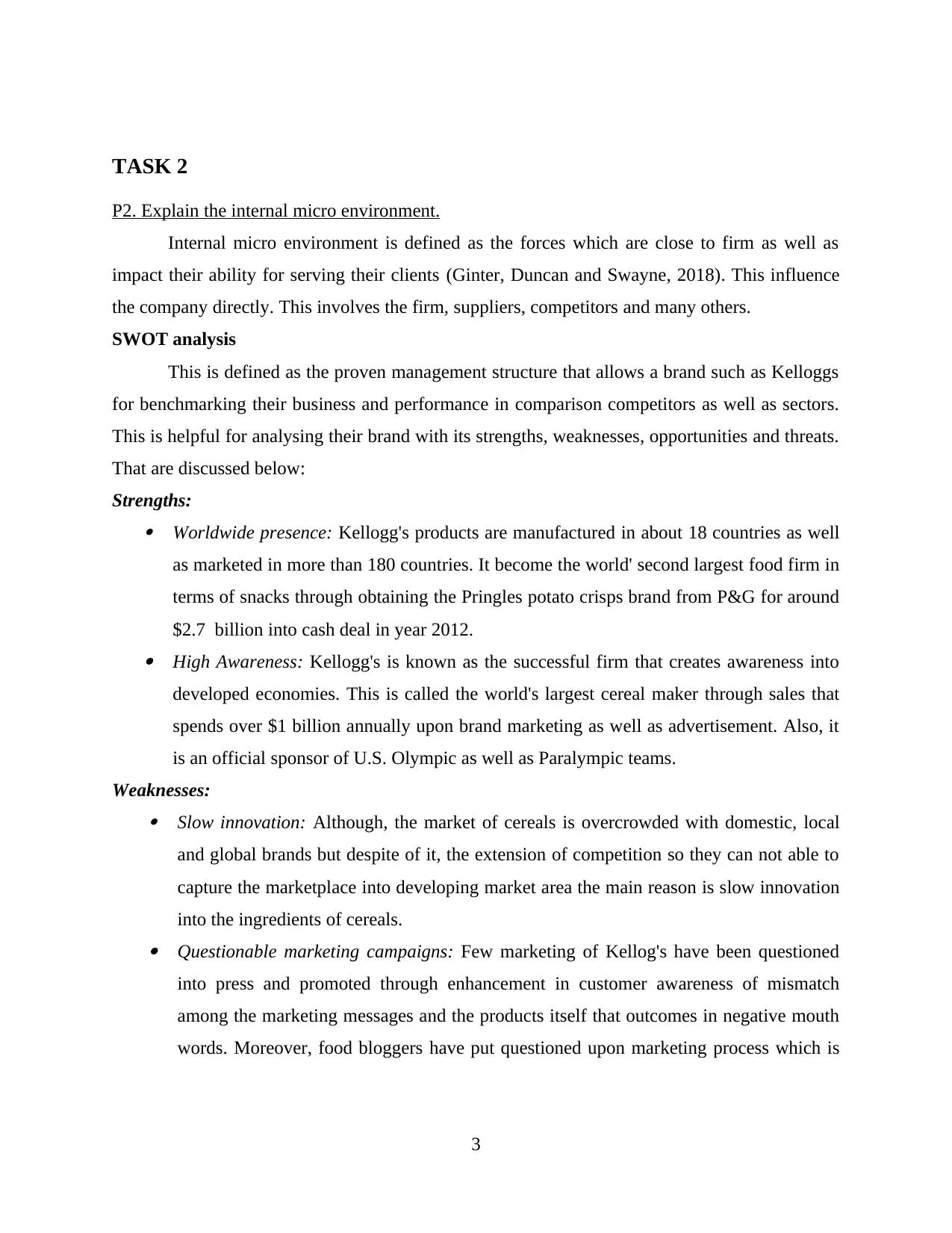
TASK 2
P2. Explain the internal micro environment.
Internal micro environment is defined as the forces which are close to firm as well as
impact their ability for serving their clients (Ginter, Duncan and Swayne, 2018). This influence
the company directly. This involves the firm, suppliers, competitors and many others.
SWOT analysis
This is defined as the proven management structure that allows a brand such as Kelloggs
for benchmarking their business and performance in comparison competitors as well as sectors.
This is helpful for analysing their brand with its strengths, weaknesses, opportunities and threats.
That are discussed below:
Strengths: Worldwide presence: Kellogg's products are manufactured in about 18 countries as well
as marketed in more than 180 countries. It become the world' second largest food firm in
terms of snacks through obtaining the Pringles potato crisps brand from P&G for around
$2.7 billion into cash deal in year 2012. High Awareness: Kellogg's is known as the successful firm that creates awareness into
developed economies. This is called the world's largest cereal maker through sales that
spends over $1 billion annually upon brand marketing as well as advertisement. Also, it
is an official sponsor of U.S. Olympic as well as Paralympic teams.
Weaknesses: Slow innovation: Although, the market of cereals is overcrowded with domestic, local
and global brands but despite of it, the extension of competition so they can not able to
capture the marketplace into developing market area the main reason is slow innovation
into the ingredients of cereals. Questionable marketing campaigns: Few marketing of Kellog's have been questioned
into press and promoted through enhancement in customer awareness of mismatch
among the marketing messages and the products itself that outcomes in negative mouth
words. Moreover, food bloggers have put questioned upon marketing process which is
3
P2. Explain the internal micro environment.
Internal micro environment is defined as the forces which are close to firm as well as
impact their ability for serving their clients (Ginter, Duncan and Swayne, 2018). This influence
the company directly. This involves the firm, suppliers, competitors and many others.
SWOT analysis
This is defined as the proven management structure that allows a brand such as Kelloggs
for benchmarking their business and performance in comparison competitors as well as sectors.
This is helpful for analysing their brand with its strengths, weaknesses, opportunities and threats.
That are discussed below:
Strengths: Worldwide presence: Kellogg's products are manufactured in about 18 countries as well
as marketed in more than 180 countries. It become the world' second largest food firm in
terms of snacks through obtaining the Pringles potato crisps brand from P&G for around
$2.7 billion into cash deal in year 2012. High Awareness: Kellogg's is known as the successful firm that creates awareness into
developed economies. This is called the world's largest cereal maker through sales that
spends over $1 billion annually upon brand marketing as well as advertisement. Also, it
is an official sponsor of U.S. Olympic as well as Paralympic teams.
Weaknesses: Slow innovation: Although, the market of cereals is overcrowded with domestic, local
and global brands but despite of it, the extension of competition so they can not able to
capture the marketplace into developing market area the main reason is slow innovation
into the ingredients of cereals. Questionable marketing campaigns: Few marketing of Kellog's have been questioned
into press and promoted through enhancement in customer awareness of mismatch
among the marketing messages and the products itself that outcomes in negative mouth
words. Moreover, food bloggers have put questioned upon marketing process which is
3
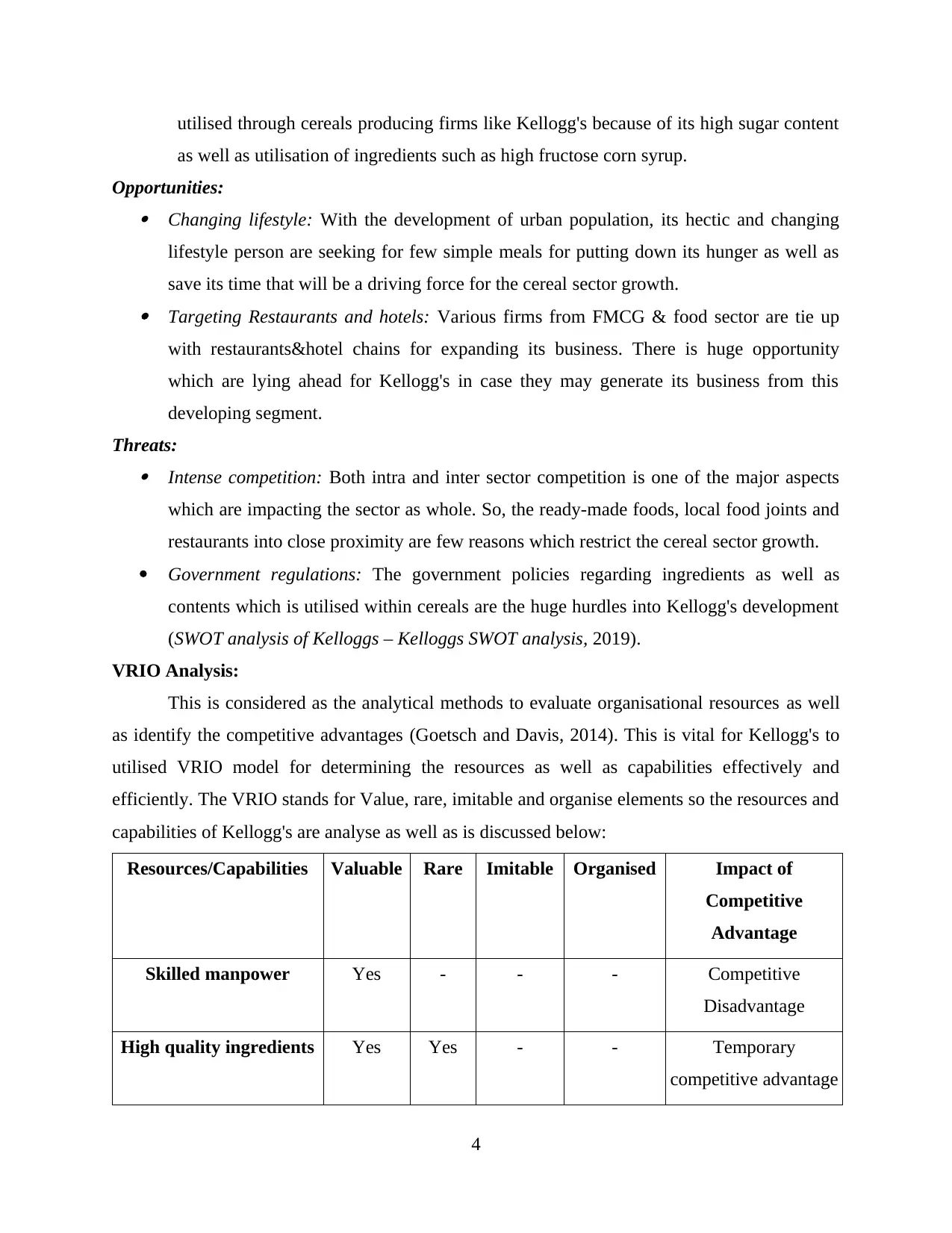
utilised through cereals producing firms like Kellogg's because of its high sugar content
as well as utilisation of ingredients such as high fructose corn syrup.
Opportunities: Changing lifestyle: With the development of urban population, its hectic and changing
lifestyle person are seeking for few simple meals for putting down its hunger as well as
save its time that will be a driving force for the cereal sector growth. Targeting Restaurants and hotels: Various firms from FMCG & food sector are tie up
with restaurants&hotel chains for expanding its business. There is huge opportunity
which are lying ahead for Kellogg's in case they may generate its business from this
developing segment.
Threats: Intense competition: Both intra and inter sector competition is one of the major aspects
which are impacting the sector as whole. So, the ready-made foods, local food joints and
restaurants into close proximity are few reasons which restrict the cereal sector growth.
Government regulations: The government policies regarding ingredients as well as
contents which is utilised within cereals are the huge hurdles into Kellogg's development
(SWOT analysis of Kelloggs – Kelloggs SWOT analysis, 2019).
VRIO Analysis:
This is considered as the analytical methods to evaluate organisational resources as well
as identify the competitive advantages (Goetsch and Davis, 2014). This is vital for Kellogg's to
utilised VRIO model for determining the resources as well as capabilities effectively and
efficiently. The VRIO stands for Value, rare, imitable and organise elements so the resources and
capabilities of Kellogg's are analyse as well as is discussed below:
Resources/Capabilities Valuable Rare Imitable Organised Impact of
Competitive
Advantage
Skilled manpower Yes - - - Competitive
Disadvantage
High quality ingredients Yes Yes - - Temporary
competitive advantage
4
as well as utilisation of ingredients such as high fructose corn syrup.
Opportunities: Changing lifestyle: With the development of urban population, its hectic and changing
lifestyle person are seeking for few simple meals for putting down its hunger as well as
save its time that will be a driving force for the cereal sector growth. Targeting Restaurants and hotels: Various firms from FMCG & food sector are tie up
with restaurants&hotel chains for expanding its business. There is huge opportunity
which are lying ahead for Kellogg's in case they may generate its business from this
developing segment.
Threats: Intense competition: Both intra and inter sector competition is one of the major aspects
which are impacting the sector as whole. So, the ready-made foods, local food joints and
restaurants into close proximity are few reasons which restrict the cereal sector growth.
Government regulations: The government policies regarding ingredients as well as
contents which is utilised within cereals are the huge hurdles into Kellogg's development
(SWOT analysis of Kelloggs – Kelloggs SWOT analysis, 2019).
VRIO Analysis:
This is considered as the analytical methods to evaluate organisational resources as well
as identify the competitive advantages (Goetsch and Davis, 2014). This is vital for Kellogg's to
utilised VRIO model for determining the resources as well as capabilities effectively and
efficiently. The VRIO stands for Value, rare, imitable and organise elements so the resources and
capabilities of Kellogg's are analyse as well as is discussed below:
Resources/Capabilities Valuable Rare Imitable Organised Impact of
Competitive
Advantage
Skilled manpower Yes - - - Competitive
Disadvantage
High quality ingredients Yes Yes - - Temporary
competitive advantage
4
⊘ This is a preview!⊘
Do you want full access?
Subscribe today to unlock all pages.

Trusted by 1+ million students worldwide
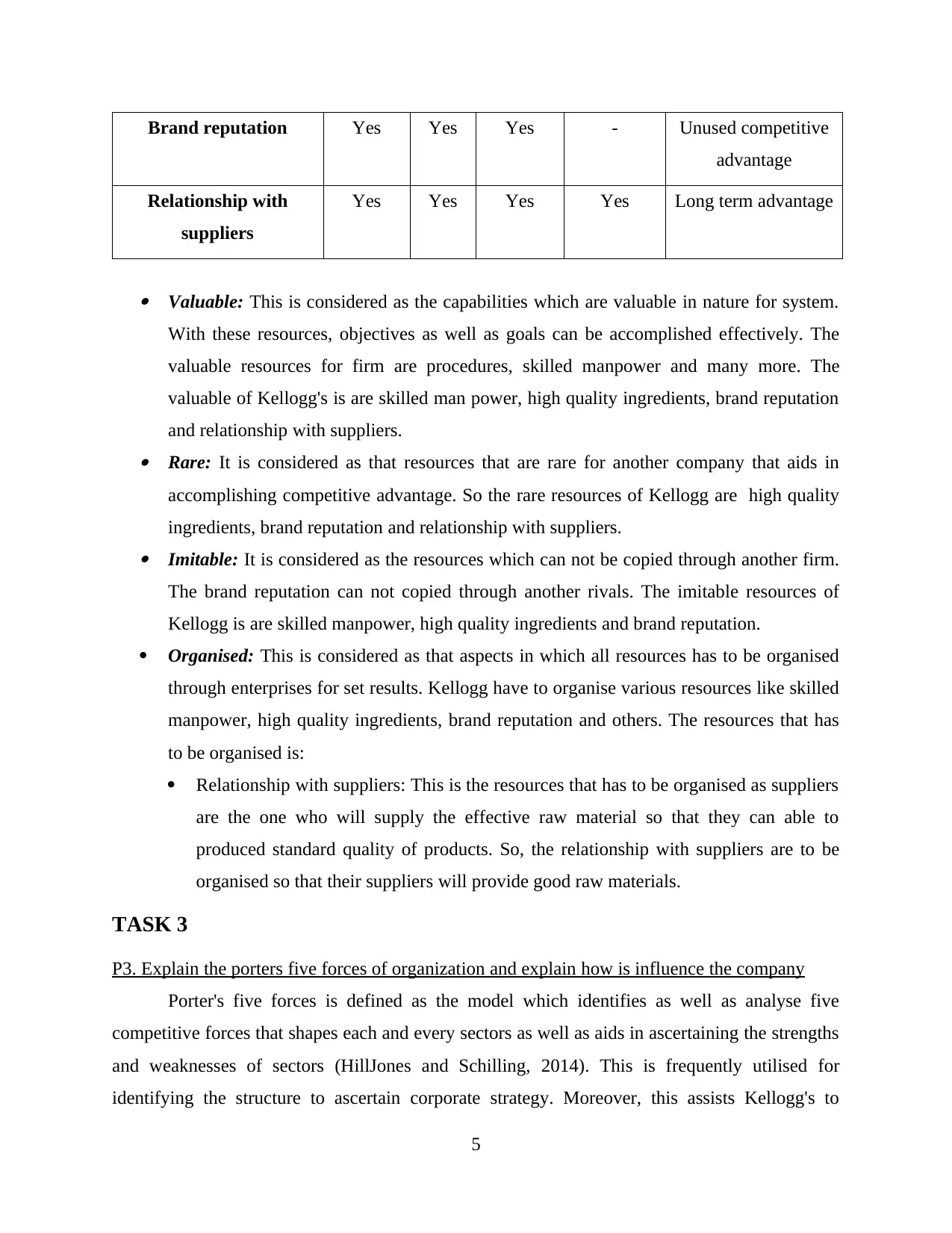
Brand reputation Yes Yes Yes - Unused competitive
advantage
Relationship with
suppliers
Yes Yes Yes Yes Long term advantage
Valuable: This is considered as the capabilities which are valuable in nature for system.
With these resources, objectives as well as goals can be accomplished effectively. The
valuable resources for firm are procedures, skilled manpower and many more. The
valuable of Kellogg's is are skilled man power, high quality ingredients, brand reputation
and relationship with suppliers. Rare: It is considered as that resources that are rare for another company that aids in
accomplishing competitive advantage. So the rare resources of Kellogg are high quality
ingredients, brand reputation and relationship with suppliers. Imitable: It is considered as the resources which can not be copied through another firm.
The brand reputation can not copied through another rivals. The imitable resources of
Kellogg is are skilled manpower, high quality ingredients and brand reputation.
Organised: This is considered as that aspects in which all resources has to be organised
through enterprises for set results. Kellogg have to organise various resources like skilled
manpower, high quality ingredients, brand reputation and others. The resources that has
to be organised is:
Relationship with suppliers: This is the resources that has to be organised as suppliers
are the one who will supply the effective raw material so that they can able to
produced standard quality of products. So, the relationship with suppliers are to be
organised so that their suppliers will provide good raw materials.
TASK 3
P3. Explain the porters five forces of organization and explain how is influence the company
Porter's five forces is defined as the model which identifies as well as analyse five
competitive forces that shapes each and every sectors as well as aids in ascertaining the strengths
and weaknesses of sectors (HillJones and Schilling, 2014). This is frequently utilised for
identifying the structure to ascertain corporate strategy. Moreover, this assists Kellogg's to
5
advantage
Relationship with
suppliers
Yes Yes Yes Yes Long term advantage
Valuable: This is considered as the capabilities which are valuable in nature for system.
With these resources, objectives as well as goals can be accomplished effectively. The
valuable resources for firm are procedures, skilled manpower and many more. The
valuable of Kellogg's is are skilled man power, high quality ingredients, brand reputation
and relationship with suppliers. Rare: It is considered as that resources that are rare for another company that aids in
accomplishing competitive advantage. So the rare resources of Kellogg are high quality
ingredients, brand reputation and relationship with suppliers. Imitable: It is considered as the resources which can not be copied through another firm.
The brand reputation can not copied through another rivals. The imitable resources of
Kellogg is are skilled manpower, high quality ingredients and brand reputation.
Organised: This is considered as that aspects in which all resources has to be organised
through enterprises for set results. Kellogg have to organise various resources like skilled
manpower, high quality ingredients, brand reputation and others. The resources that has
to be organised is:
Relationship with suppliers: This is the resources that has to be organised as suppliers
are the one who will supply the effective raw material so that they can able to
produced standard quality of products. So, the relationship with suppliers are to be
organised so that their suppliers will provide good raw materials.
TASK 3
P3. Explain the porters five forces of organization and explain how is influence the company
Porter's five forces is defined as the model which identifies as well as analyse five
competitive forces that shapes each and every sectors as well as aids in ascertaining the strengths
and weaknesses of sectors (HillJones and Schilling, 2014). This is frequently utilised for
identifying the structure to ascertain corporate strategy. Moreover, this assists Kellogg's to
5
Paraphrase This Document
Need a fresh take? Get an instant paraphrase of this document with our AI Paraphraser
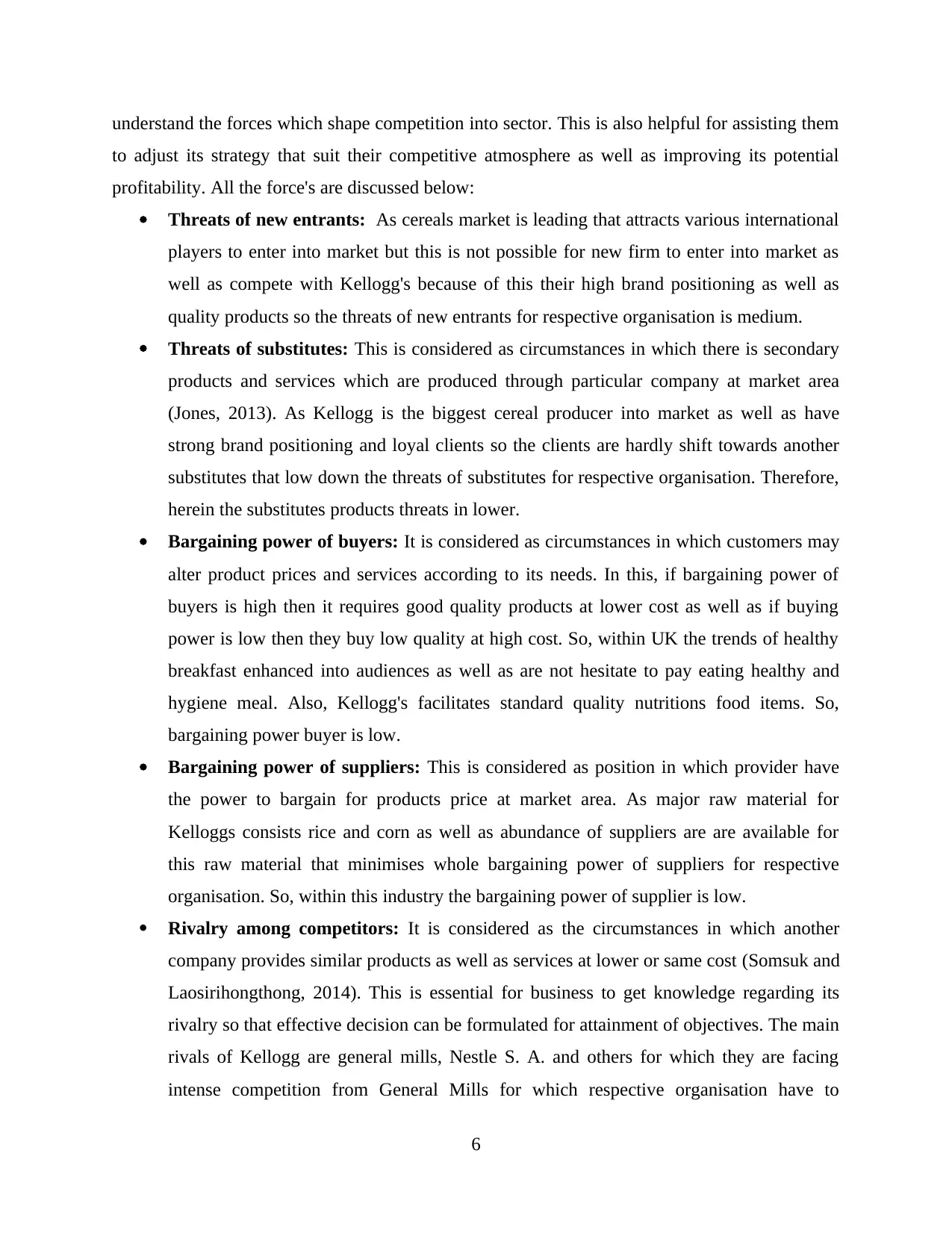
understand the forces which shape competition into sector. This is also helpful for assisting them
to adjust its strategy that suit their competitive atmosphere as well as improving its potential
profitability. All the force's are discussed below:
Threats of new entrants: As cereals market is leading that attracts various international
players to enter into market but this is not possible for new firm to enter into market as
well as compete with Kellogg's because of this their high brand positioning as well as
quality products so the threats of new entrants for respective organisation is medium.
Threats of substitutes: This is considered as circumstances in which there is secondary
products and services which are produced through particular company at market area
(Jones, 2013). As Kellogg is the biggest cereal producer into market as well as have
strong brand positioning and loyal clients so the clients are hardly shift towards another
substitutes that low down the threats of substitutes for respective organisation. Therefore,
herein the substitutes products threats in lower.
Bargaining power of buyers: It is considered as circumstances in which customers may
alter product prices and services according to its needs. In this, if bargaining power of
buyers is high then it requires good quality products at lower cost as well as if buying
power is low then they buy low quality at high cost. So, within UK the trends of healthy
breakfast enhanced into audiences as well as are not hesitate to pay eating healthy and
hygiene meal. Also, Kellogg's facilitates standard quality nutritions food items. So,
bargaining power buyer is low.
Bargaining power of suppliers: This is considered as position in which provider have
the power to bargain for products price at market area. As major raw material for
Kelloggs consists rice and corn as well as abundance of suppliers are are available for
this raw material that minimises whole bargaining power of suppliers for respective
organisation. So, within this industry the bargaining power of supplier is low.
Rivalry among competitors: It is considered as the circumstances in which another
company provides similar products as well as services at lower or same cost (Somsuk and
Laosirihongthong, 2014). This is essential for business to get knowledge regarding its
rivalry so that effective decision can be formulated for attainment of objectives. The main
rivals of Kellogg are general mills, Nestle S. A. and others for which they are facing
intense competition from General Mills for which respective organisation have to
6
to adjust its strategy that suit their competitive atmosphere as well as improving its potential
profitability. All the force's are discussed below:
Threats of new entrants: As cereals market is leading that attracts various international
players to enter into market but this is not possible for new firm to enter into market as
well as compete with Kellogg's because of this their high brand positioning as well as
quality products so the threats of new entrants for respective organisation is medium.
Threats of substitutes: This is considered as circumstances in which there is secondary
products and services which are produced through particular company at market area
(Jones, 2013). As Kellogg is the biggest cereal producer into market as well as have
strong brand positioning and loyal clients so the clients are hardly shift towards another
substitutes that low down the threats of substitutes for respective organisation. Therefore,
herein the substitutes products threats in lower.
Bargaining power of buyers: It is considered as circumstances in which customers may
alter product prices and services according to its needs. In this, if bargaining power of
buyers is high then it requires good quality products at lower cost as well as if buying
power is low then they buy low quality at high cost. So, within UK the trends of healthy
breakfast enhanced into audiences as well as are not hesitate to pay eating healthy and
hygiene meal. Also, Kellogg's facilitates standard quality nutritions food items. So,
bargaining power buyer is low.
Bargaining power of suppliers: This is considered as position in which provider have
the power to bargain for products price at market area. As major raw material for
Kelloggs consists rice and corn as well as abundance of suppliers are are available for
this raw material that minimises whole bargaining power of suppliers for respective
organisation. So, within this industry the bargaining power of supplier is low.
Rivalry among competitors: It is considered as the circumstances in which another
company provides similar products as well as services at lower or same cost (Somsuk and
Laosirihongthong, 2014). This is essential for business to get knowledge regarding its
rivalry so that effective decision can be formulated for attainment of objectives. The main
rivals of Kellogg are general mills, Nestle S. A. and others for which they are facing
intense competition from General Mills for which respective organisation have to
6
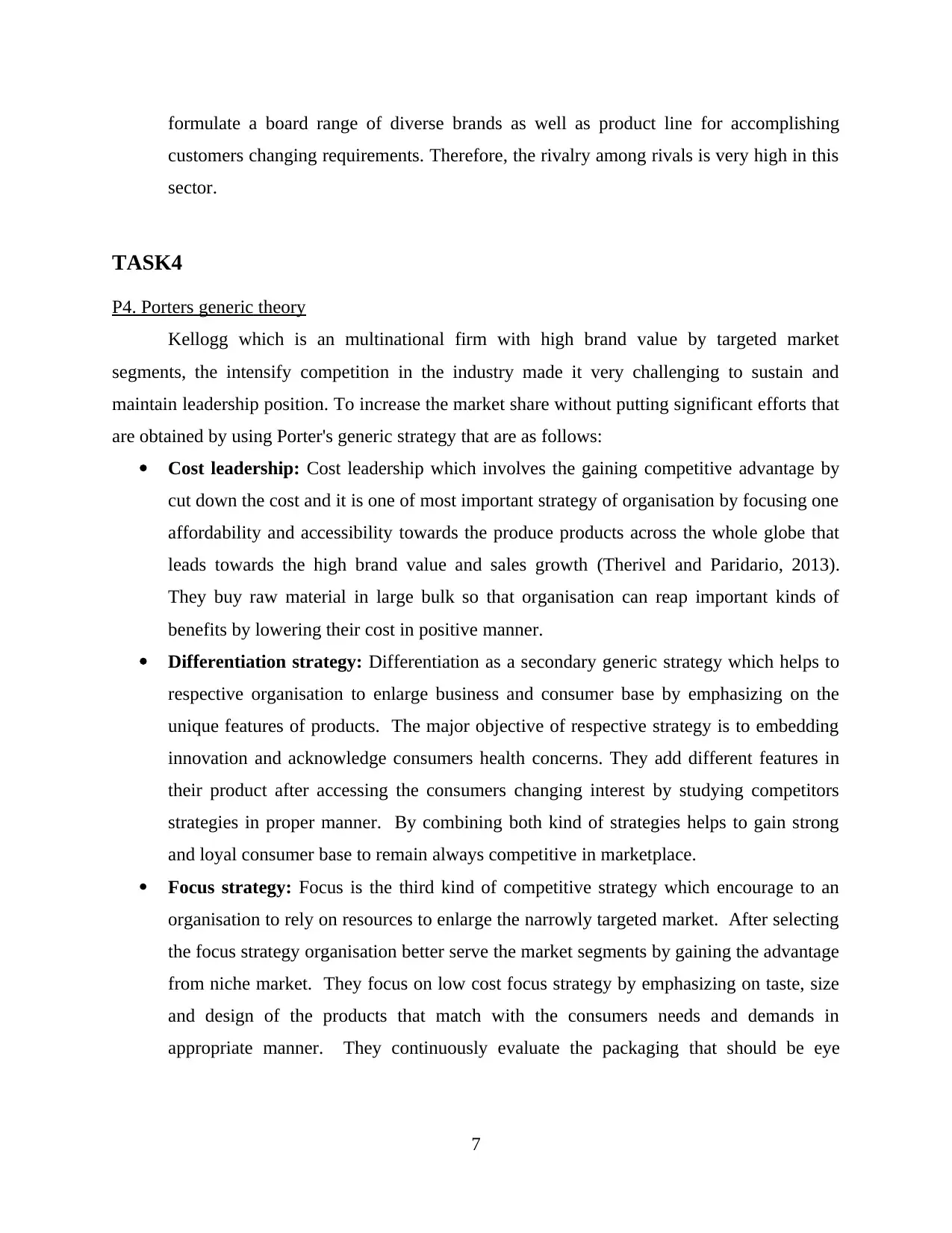
formulate a board range of diverse brands as well as product line for accomplishing
customers changing requirements. Therefore, the rivalry among rivals is very high in this
sector.
TASK4
P4. Porters generic theory
Kellogg which is an multinational firm with high brand value by targeted market
segments, the intensify competition in the industry made it very challenging to sustain and
maintain leadership position. To increase the market share without putting significant efforts that
are obtained by using Porter's generic strategy that are as follows:
Cost leadership: Cost leadership which involves the gaining competitive advantage by
cut down the cost and it is one of most important strategy of organisation by focusing one
affordability and accessibility towards the produce products across the whole globe that
leads towards the high brand value and sales growth (Therivel and Paridario, 2013).
They buy raw material in large bulk so that organisation can reap important kinds of
benefits by lowering their cost in positive manner.
Differentiation strategy: Differentiation as a secondary generic strategy which helps to
respective organisation to enlarge business and consumer base by emphasizing on the
unique features of products. The major objective of respective strategy is to embedding
innovation and acknowledge consumers health concerns. They add different features in
their product after accessing the consumers changing interest by studying competitors
strategies in proper manner. By combining both kind of strategies helps to gain strong
and loyal consumer base to remain always competitive in marketplace.
Focus strategy: Focus is the third kind of competitive strategy which encourage to an
organisation to rely on resources to enlarge the narrowly targeted market. After selecting
the focus strategy organisation better serve the market segments by gaining the advantage
from niche market. They focus on low cost focus strategy by emphasizing on taste, size
and design of the products that match with the consumers needs and demands in
appropriate manner. They continuously evaluate the packaging that should be eye
7
customers changing requirements. Therefore, the rivalry among rivals is very high in this
sector.
TASK4
P4. Porters generic theory
Kellogg which is an multinational firm with high brand value by targeted market
segments, the intensify competition in the industry made it very challenging to sustain and
maintain leadership position. To increase the market share without putting significant efforts that
are obtained by using Porter's generic strategy that are as follows:
Cost leadership: Cost leadership which involves the gaining competitive advantage by
cut down the cost and it is one of most important strategy of organisation by focusing one
affordability and accessibility towards the produce products across the whole globe that
leads towards the high brand value and sales growth (Therivel and Paridario, 2013).
They buy raw material in large bulk so that organisation can reap important kinds of
benefits by lowering their cost in positive manner.
Differentiation strategy: Differentiation as a secondary generic strategy which helps to
respective organisation to enlarge business and consumer base by emphasizing on the
unique features of products. The major objective of respective strategy is to embedding
innovation and acknowledge consumers health concerns. They add different features in
their product after accessing the consumers changing interest by studying competitors
strategies in proper manner. By combining both kind of strategies helps to gain strong
and loyal consumer base to remain always competitive in marketplace.
Focus strategy: Focus is the third kind of competitive strategy which encourage to an
organisation to rely on resources to enlarge the narrowly targeted market. After selecting
the focus strategy organisation better serve the market segments by gaining the advantage
from niche market. They focus on low cost focus strategy by emphasizing on taste, size
and design of the products that match with the consumers needs and demands in
appropriate manner. They continuously evaluate the packaging that should be eye
7
⊘ This is a preview!⊘
Do you want full access?
Subscribe today to unlock all pages.

Trusted by 1+ million students worldwide
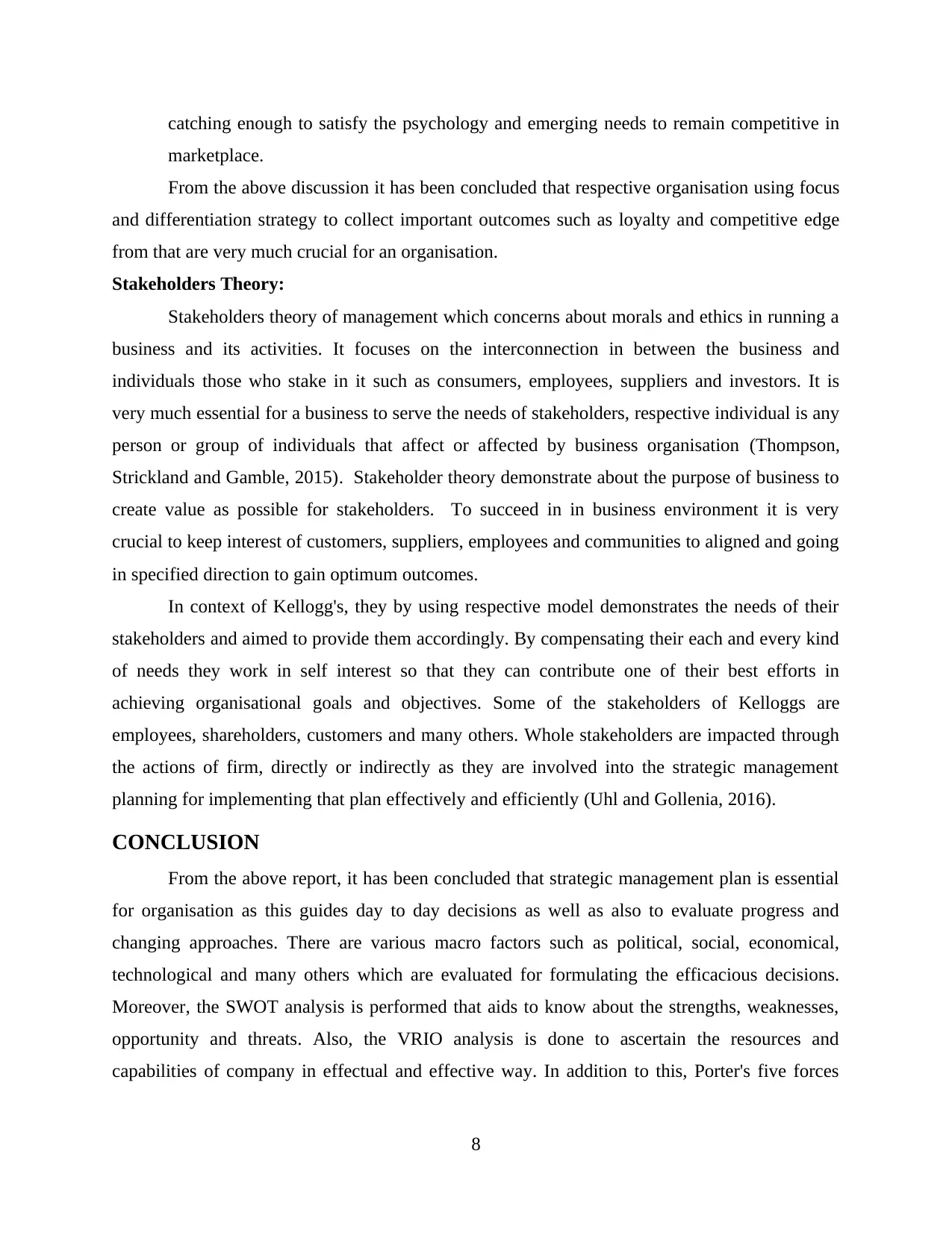
catching enough to satisfy the psychology and emerging needs to remain competitive in
marketplace.
From the above discussion it has been concluded that respective organisation using focus
and differentiation strategy to collect important outcomes such as loyalty and competitive edge
from that are very much crucial for an organisation.
Stakeholders Theory:
Stakeholders theory of management which concerns about morals and ethics in running a
business and its activities. It focuses on the interconnection in between the business and
individuals those who stake in it such as consumers, employees, suppliers and investors. It is
very much essential for a business to serve the needs of stakeholders, respective individual is any
person or group of individuals that affect or affected by business organisation (Thompson,
Strickland and Gamble, 2015). Stakeholder theory demonstrate about the purpose of business to
create value as possible for stakeholders. To succeed in in business environment it is very
crucial to keep interest of customers, suppliers, employees and communities to aligned and going
in specified direction to gain optimum outcomes.
In context of Kellogg's, they by using respective model demonstrates the needs of their
stakeholders and aimed to provide them accordingly. By compensating their each and every kind
of needs they work in self interest so that they can contribute one of their best efforts in
achieving organisational goals and objectives. Some of the stakeholders of Kelloggs are
employees, shareholders, customers and many others. Whole stakeholders are impacted through
the actions of firm, directly or indirectly as they are involved into the strategic management
planning for implementing that plan effectively and efficiently (Uhl and Gollenia, 2016).
CONCLUSION
From the above report, it has been concluded that strategic management plan is essential
for organisation as this guides day to day decisions as well as also to evaluate progress and
changing approaches. There are various macro factors such as political, social, economical,
technological and many others which are evaluated for formulating the efficacious decisions.
Moreover, the SWOT analysis is performed that aids to know about the strengths, weaknesses,
opportunity and threats. Also, the VRIO analysis is done to ascertain the resources and
capabilities of company in effectual and effective way. In addition to this, Porter's five forces
8
marketplace.
From the above discussion it has been concluded that respective organisation using focus
and differentiation strategy to collect important outcomes such as loyalty and competitive edge
from that are very much crucial for an organisation.
Stakeholders Theory:
Stakeholders theory of management which concerns about morals and ethics in running a
business and its activities. It focuses on the interconnection in between the business and
individuals those who stake in it such as consumers, employees, suppliers and investors. It is
very much essential for a business to serve the needs of stakeholders, respective individual is any
person or group of individuals that affect or affected by business organisation (Thompson,
Strickland and Gamble, 2015). Stakeholder theory demonstrate about the purpose of business to
create value as possible for stakeholders. To succeed in in business environment it is very
crucial to keep interest of customers, suppliers, employees and communities to aligned and going
in specified direction to gain optimum outcomes.
In context of Kellogg's, they by using respective model demonstrates the needs of their
stakeholders and aimed to provide them accordingly. By compensating their each and every kind
of needs they work in self interest so that they can contribute one of their best efforts in
achieving organisational goals and objectives. Some of the stakeholders of Kelloggs are
employees, shareholders, customers and many others. Whole stakeholders are impacted through
the actions of firm, directly or indirectly as they are involved into the strategic management
planning for implementing that plan effectively and efficiently (Uhl and Gollenia, 2016).
CONCLUSION
From the above report, it has been concluded that strategic management plan is essential
for organisation as this guides day to day decisions as well as also to evaluate progress and
changing approaches. There are various macro factors such as political, social, economical,
technological and many others which are evaluated for formulating the efficacious decisions.
Moreover, the SWOT analysis is performed that aids to know about the strengths, weaknesses,
opportunity and threats. Also, the VRIO analysis is done to ascertain the resources and
capabilities of company in effectual and effective way. In addition to this, Porter's five forces
8
Paraphrase This Document
Need a fresh take? Get an instant paraphrase of this document with our AI Paraphraser
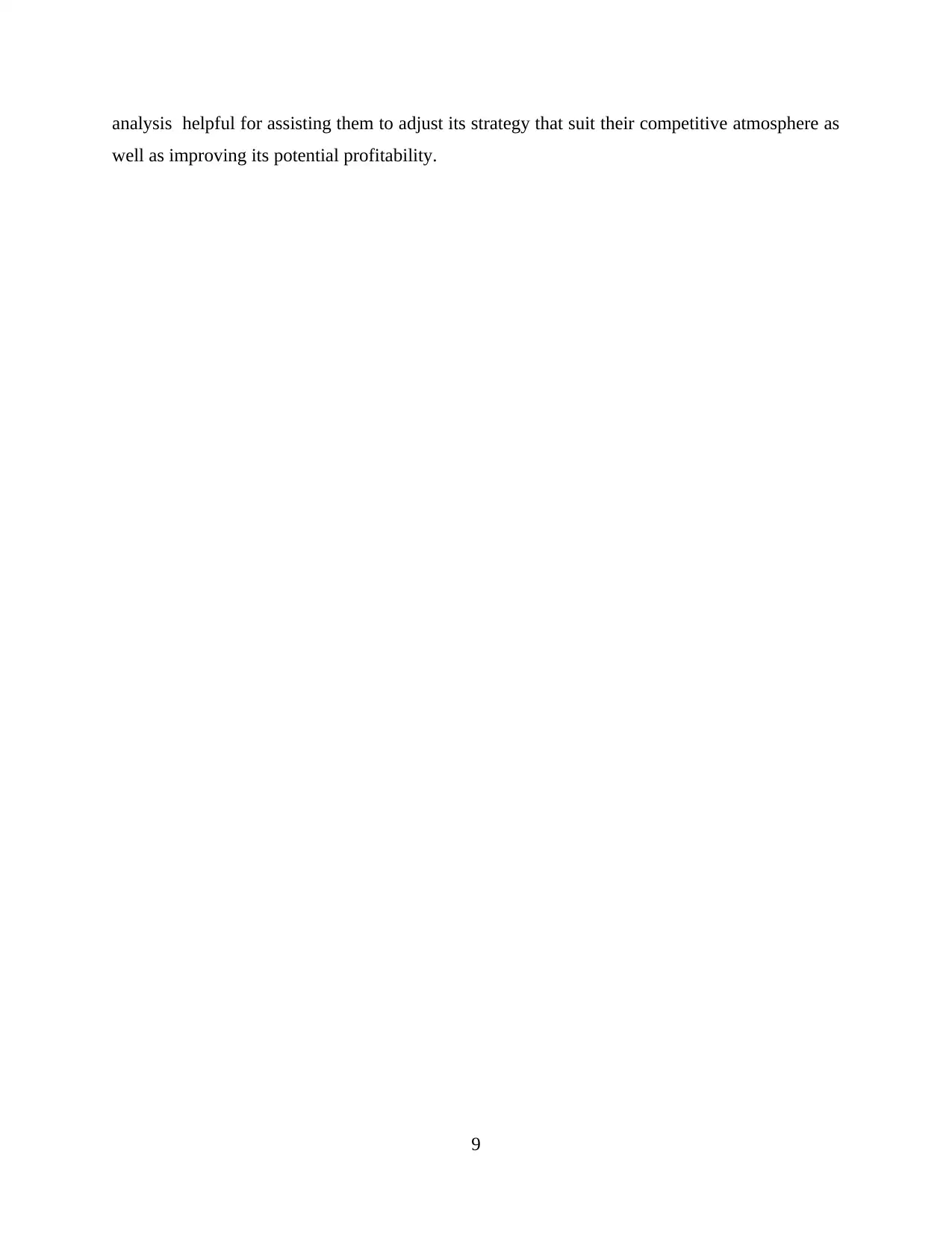
analysis helpful for assisting them to adjust its strategy that suit their competitive atmosphere as
well as improving its potential profitability.
9
well as improving its potential profitability.
9
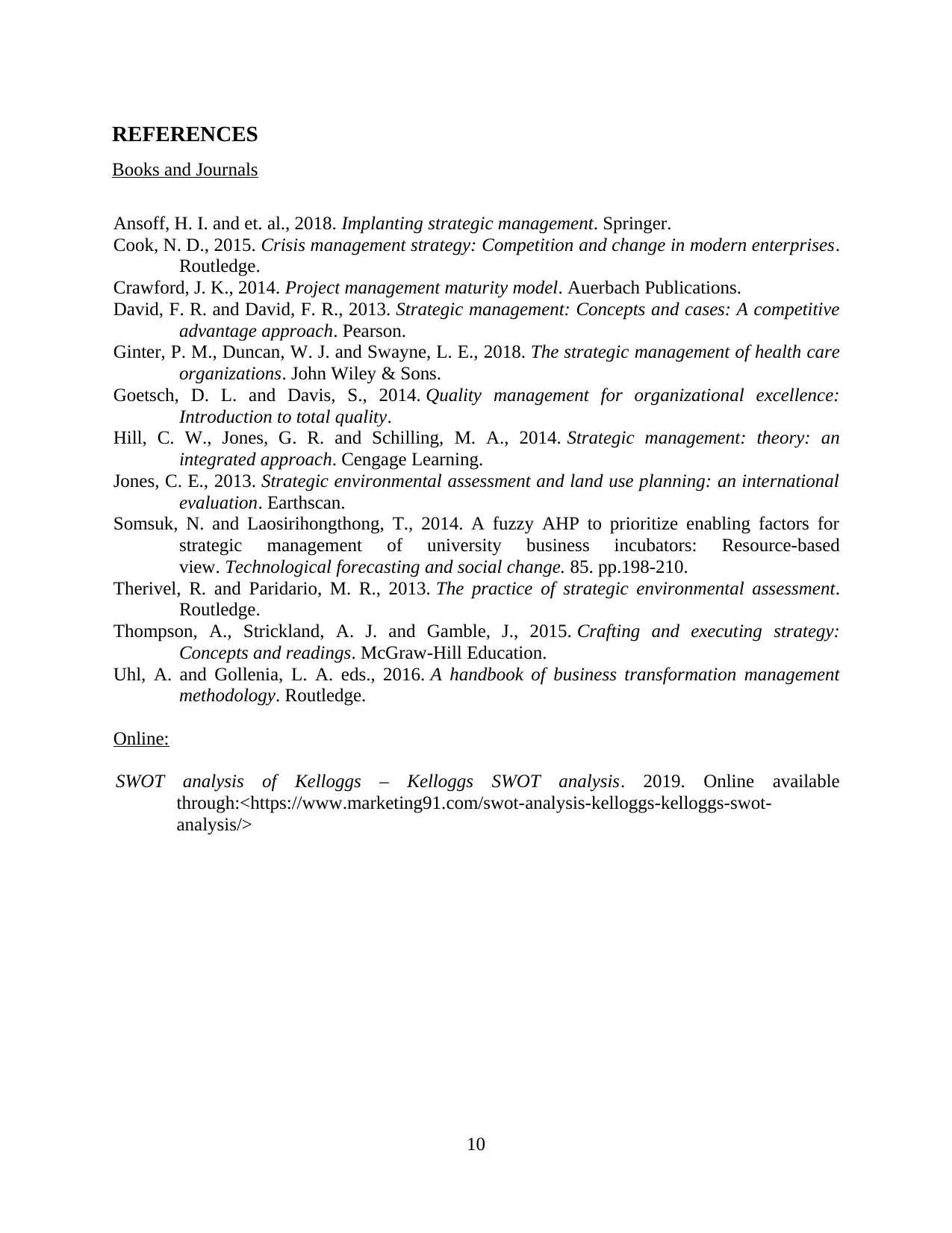
REFERENCES
Books and Journals
Ansoff, H. I. and et. al., 2018. Implanting strategic management. Springer.
Cook, N. D., 2015. Crisis management strategy: Competition and change in modern enterprises.
Routledge.
Crawford, J. K., 2014. Project management maturity model. Auerbach Publications.
David, F. R. and David, F. R., 2013. Strategic management: Concepts and cases: A competitive
advantage approach. Pearson.
Ginter, P. M., Duncan, W. J. and Swayne, L. E., 2018. The strategic management of health care
organizations. John Wiley & Sons.
Goetsch, D. L. and Davis, S., 2014. Quality management for organizational excellence:
Introduction to total quality.
Hill, C. W., Jones, G. R. and Schilling, M. A., 2014. Strategic management: theory: an
integrated approach. Cengage Learning.
Jones, C. E., 2013. Strategic environmental assessment and land use planning: an international
evaluation. Earthscan.
Somsuk, N. and Laosirihongthong, T., 2014. A fuzzy AHP to prioritize enabling factors for
strategic management of university business incubators: Resource-based
view. Technological forecasting and social change. 85. pp.198-210.
Therivel, R. and Paridario, M. R., 2013. The practice of strategic environmental assessment.
Routledge.
Thompson, A., Strickland, A. J. and Gamble, J., 2015. Crafting and executing strategy:
Concepts and readings. McGraw-Hill Education.
Uhl, A. and Gollenia, L. A. eds., 2016. A handbook of business transformation management
methodology. Routledge.
Online:
SWOT analysis of Kelloggs – Kelloggs SWOT analysis. 2019. Online available
through:<https://www.marketing91.com/swot-analysis-kelloggs-kelloggs-swot-
analysis/>
10
Books and Journals
Ansoff, H. I. and et. al., 2018. Implanting strategic management. Springer.
Cook, N. D., 2015. Crisis management strategy: Competition and change in modern enterprises.
Routledge.
Crawford, J. K., 2014. Project management maturity model. Auerbach Publications.
David, F. R. and David, F. R., 2013. Strategic management: Concepts and cases: A competitive
advantage approach. Pearson.
Ginter, P. M., Duncan, W. J. and Swayne, L. E., 2018. The strategic management of health care
organizations. John Wiley & Sons.
Goetsch, D. L. and Davis, S., 2014. Quality management for organizational excellence:
Introduction to total quality.
Hill, C. W., Jones, G. R. and Schilling, M. A., 2014. Strategic management: theory: an
integrated approach. Cengage Learning.
Jones, C. E., 2013. Strategic environmental assessment and land use planning: an international
evaluation. Earthscan.
Somsuk, N. and Laosirihongthong, T., 2014. A fuzzy AHP to prioritize enabling factors for
strategic management of university business incubators: Resource-based
view. Technological forecasting and social change. 85. pp.198-210.
Therivel, R. and Paridario, M. R., 2013. The practice of strategic environmental assessment.
Routledge.
Thompson, A., Strickland, A. J. and Gamble, J., 2015. Crafting and executing strategy:
Concepts and readings. McGraw-Hill Education.
Uhl, A. and Gollenia, L. A. eds., 2016. A handbook of business transformation management
methodology. Routledge.
Online:
SWOT analysis of Kelloggs – Kelloggs SWOT analysis. 2019. Online available
through:<https://www.marketing91.com/swot-analysis-kelloggs-kelloggs-swot-
analysis/>
10
⊘ This is a preview!⊘
Do you want full access?
Subscribe today to unlock all pages.

Trusted by 1+ million students worldwide
1 out of 12
Related Documents
Your All-in-One AI-Powered Toolkit for Academic Success.
+13062052269
info@desklib.com
Available 24*7 on WhatsApp / Email
![[object Object]](/_next/static/media/star-bottom.7253800d.svg)
Unlock your academic potential
Copyright © 2020–2025 A2Z Services. All Rights Reserved. Developed and managed by ZUCOL.





